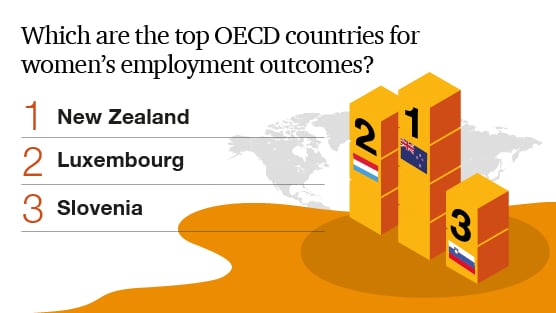{{item.title}}
{{item.text}}

{{item.text}}
This year, we celebrate a decade of PwC’s Women in Work Index. The report gives us an opportunity to reflect on the very real impacts of the COVID-19 pandemic on women’s lives, jobs, economic prosperity, and broader wellbeing; and importantly, to look towards the future.
In 2020, the Women in Work Index fell for the first time in its history. After a decade of slow but steady improvement in women’s employment outcomes, progress towards gender equality in work was set back by at least two years across Organisation for Economic Cooperation and Development (OECD) countries.*. The main contributing factors were higher female unemployment and lower female labour market participation in 2020.
Governments and businesses around the world are coming together to rebuild economies and accelerate action to address the climate crisis; as they do so, they must not ignore the opportunity to lay down a blueprint for lasting change in the workplace - change that will achieve a greener, fairer, and more prosperous future for all.
Explore the key findings from the research below and find out what governments and organisations can do to improve outcomes for women in work, and support a sustainable and inclusive economic recovery from COVID-19.
You can also explore the Women in Work Index results at a country level using our interactive data tool.
If you have any questions about our research, please do not hesitate to get in touch.
For the first time, New Zealand tops the Women in Work Index with Luxembourg and Slovenia taking second and third place. The UK is the biggest climber in the rankings, while Canada suffers the largest slide.
Switzerland moved up one place on the Index in 2020, from 15th position in 2019, to rank 14th out of the 33 OECD countries.
There is a large gap in the employment rate: while 89% of employed men work full-time, only 56% of women do (second last rank in the OECD country comparison). On the other hand, an above average number of women (80%) participate in the labour force (third rank in the OECD comparison). This shows that the majority of Swiss women work, albeit with a low workload.
The proportion of women in Swiss top management is rising steadily, but at 26%, women are still heavily underrepresented. The lack of equality is also reflected in salaries. The gender pay gap in Switzerland is 17% (OECD area 14%). Without this gap, Swiss women would earn around 23 billion CHF more annually. However, if developments in the OECD region continue at this pace, it will take another 63 years to close the gender pay gap.
The next decade of Women in Work will be shaped by the transition of global economies to net zero emissions, and the corresponding jobs created. Government and business commitments to achieving net zero are stronger than ever, and structural and technological changes within key sectors will be key in determining economic outcomes for workers.
As it stands, women are at a disadvantage: previously slow progress towards equality was set back by the pandemic, and the transition to net zero will further perpetuate inequalities unless there is a targeted intervention.
Our analysis of the energy sector’s transition to net zero shows that across the OECD, new green jobs created will be concentrated in only a few sectors: utilities, construction, and manufacturing being the clear top three. These sectors employ nearly 31% of the male workforce across the OECD, compared to only 11% of the female workforce. With new jobs concentrated in sectors that are male-dominated, men are immediately better placed to take advantage of the new opportunities.
If nothing is done to improve women’s representation in these sectors, we estimate that the employment gap between men and women across the OECD will widen by 1.7 percentage points by 2030 rising from 20.8% in 2020 to 22.5% in 2030 (instead of 22.0% in the case that OECD economies did nothing to address the climate crisis).
In addressing the climate crisis head on, we must learn from the mistakes of the pandemic, and focus on designing gender responsive policies that will enable women to have equal access to future job opportunities.
Equipping women with the right skills to successfully navigate the green jobs market is one side of the equation. This will help to create greater economic security for women by improving access to high quality and sustainable jobs in markets of long-term growth.
The other side of the equation is building a future world of work that better meets the needs of women and other marginalised groups.
Flexible working options must be accessible and equally used by everyone, both women and men, such that flexible working is accepted as standard practice, and there are no conscious or unconscious gender biases against those who work flexibly.
Affordable childcare would help to reduce the burden of unpaid care carried by women.
Equal paid parental leave should be provided by more governments and businesses, such that women’s burden of unpaid care is redistributed, and they have the same opportunities as men to participate in paid work, and advance their careers.
Only when women and men are considered equal in undertaking childcare and domestic work, will gender inequalities in the workplace be reduced.
As we look towards a fairer, greener future, we need governments, and even more importantly businesses, to lead the way by rebuilding our economies and societies with good policies and practices that put women’s needs at the centre, and are designed using an intersectional analytical framework. This will allow us to design-in equality to our future, and finally #BreakTheBias. It is not enough to imagine a gender equal world; we must all do our part to create it.
{{item.text}}

{{item.text}}

Partner, Leader Family Business and SME in Romandie, PwC Switzerland
Tel: +41 58 792 96 95

